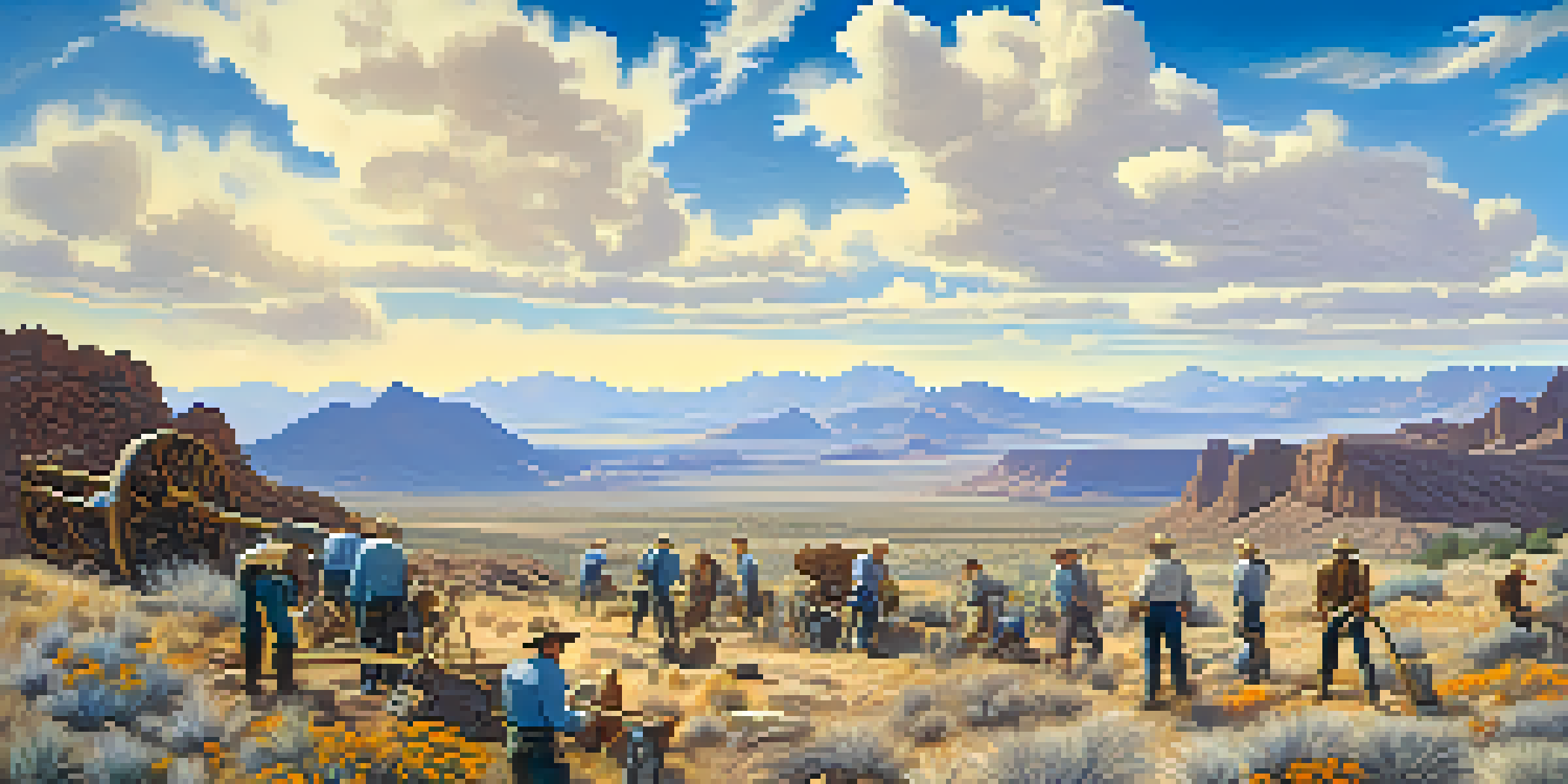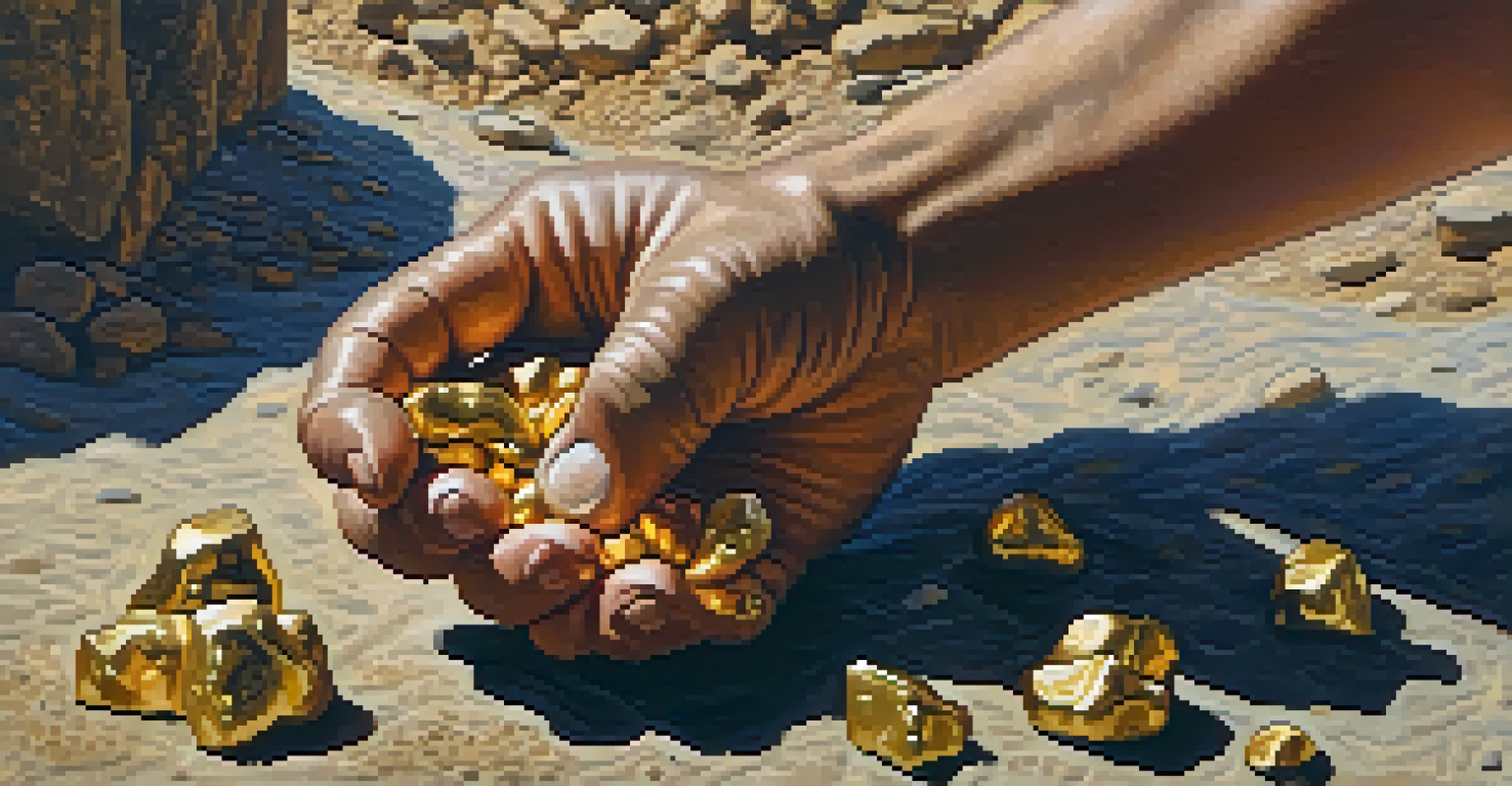Gold Rushes in Arizona: Key Events and Their Impact

The Beginnings of Gold Discovery in Arizona
The gold rush era in Arizona began in the mid-19th century, driven largely by the allure of wealth and opportunity. The discovery of gold in places like the Gila River attracted fortune seekers from across the nation. This initial spark led to a flurry of prospectors and settlers heading west, eager to stake their claims.
Gold is a treasure, and he who possesses it does all he wishes to in this world and succeeds in everything.
In 1857, a significant discovery by a man named William A. Bowles near the confluence of the Gila and Colorado Rivers marked a turning point. Bowles and his companions unearthed gold, igniting interest in mining throughout the region. As news spread, it wasn't long before thousands flocked to Arizona, hoping to strike it rich.
These early gold discoveries laid the groundwork for a series of mining towns and camps, which would become the lifeblood of the state's burgeoning economy. The population boom not only increased the demand for goods and services but also established the foundation for future mining endeavors.
The Impact of the 1863-1864 Gold Rush
The gold rush of 1863-1864 was pivotal, particularly with the discovery of gold in the Bradshaw Mountains. This event significantly boosted Arizona's profile as a mining destination. Towns like Prescott emerged almost overnight, transforming the landscape and attracting a diverse group of settlers.

During this gold rush, miners faced challenges, including harsh terrain and competition. However, the promise of untold wealth kept the influx steady, leading to a vibrant community culture. By establishing social institutions like schools and churches, these settlers began to create a sense of permanence in an otherwise transient environment.
Gold Rush Sparked Economic Growth
The influx of miners during the gold rush led to the establishment of mining towns and a diverse economy in Arizona.
The success of this gold rush also prompted investment in infrastructure; roads and railways were developed to support the booming mining industry. This not only facilitated the movement of goods but also connected previously isolated areas, fostering further economic development in Arizona.
The Role of Technology in Gold Mining
As gold mining progressed, technological advancements played a crucial role in maximizing efficiency. Innovations such as hydraulic mining and steam-powered equipment allowed miners to extract more gold from the earth with less effort. This shift not only increased production but also attracted larger companies to invest in Arizona's mining ventures.
The true measure of wealth is the ability to make a positive impact on others’ lives.
However, these advancements came with environmental costs. Hydraulic mining, for instance, significantly altered landscapes and affected local ecosystems. The consequences of this extraction method sparked debates about sustainable practices, a conversation that resonates even today.
Despite these challenges, technology continued to advance, leading to more effective gold recovery methods. This ongoing evolution ensured that Arizona remained a key player in the national mining industry, influencing the state's economy and shaping its future.
Significant Figures of the Arizona Gold Rush
Throughout Arizona's gold rush history, several key figures emerged as legends. One notable individual was John M. McGinnis, who discovered gold in the Hassayampa River area. His find not only enriched him but also spurred further exploration and settlement in the region.
Another important figure was George Washington, who became a prominent miner and businessman in the late 1800s. His investments in various mining operations helped stabilize the industry and promote economic growth. These individuals, among others, played vital roles in shaping the narrative of Arizona's gold rush.
Technological Advances Changed Mining
Innovations like hydraulic mining and steam-powered equipment increased gold production but also raised environmental concerns.
Their stories highlight the human element of the gold rush, showcasing dreams, struggles, and triumphs. These figures not only contributed to the state's wealth but also left lasting legacies that continue to be celebrated in Arizona's cultural history.
The Social Impact of Gold Rush Communities
The gold rush era was about more than just wealth; it fostered unique social dynamics within burgeoning communities. Towns like Tombstone became melting pots of diverse cultures, bringing together people from various backgrounds. This blending of cultures enriched the social fabric but also led to tensions and conflicts.
As these towns developed, they established social institutions, including schools, churches, and social clubs. These establishments played crucial roles in uniting the community and providing a sense of belonging among residents. The gold rush not only transformed the economy but also created lasting social structures.
Despite the transient nature of many gold rush towns, some evolved into permanent settlements. The bonds formed during this time contributed to a shared identity among residents, which persists in many areas of Arizona today.
Economic Consequences of the Gold Rush
The economic impact of the gold rush in Arizona was profound and far-reaching. The influx of miners and their families stimulated local economies, as businesses sprang up to cater to their needs. From supply stores to saloons, these establishments became the backbone of thriving mining towns.
Additionally, the gold rush attracted significant investments, not only in mining but also in infrastructure development. Railroads and roads were built to transport gold and supplies, paving the way for future economic growth. This infrastructure laid the foundation for Arizona's evolution into a major economic player in the Southwest.
Cultural Impact of Gold Rush Communities
Gold rush towns became melting pots of diverse cultures, fostering social institutions that shaped the community's identity.
While the initial rush was driven by gold, the long-term economic consequences included a diverse range of industries. Agriculture, tourism, and manufacturing grew in tandem with mining, showcasing Arizona's ability to adapt and thrive beyond its gold rush roots.
Legacy of Arizona's Gold Rushes Today
The legacy of the gold rushes in Arizona is evident in the state's culture and economy. Today, many towns that prospered during this era still celebrate their mining heritage through festivals and historical sites. These events attract tourists and serve as reminders of the adventurous spirit that characterized the gold rush.
Moreover, the mining industry has evolved, with modern practices emphasizing sustainability and responsibility. Lessons learned from the past have prompted a shift towards more environmentally friendly methods, ensuring that Arizona's natural resources are preserved for future generations.

In essence, the gold rushes laid the groundwork for the Arizona we know today. The stories of ambition, struggle, and resilience continue to resonate, shaping the identity of the state and its people.